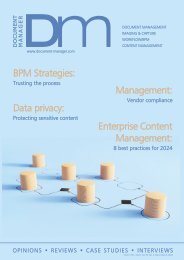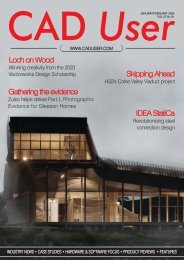You also want an ePaper? Increase the reach of your titles
YUMPU automatically turns print PDFs into web optimized ePapers that Google loves.
CASEstudy<br />
Solid Groundwork<br />
Laying in a solid accounting system like EasyBuild is as beneficial to a civil engineering company as<br />
laying good groundworks, as T & W Civil Engineering have discovered<br />
In a year beset with problems and<br />
hardship for many, there are thanks to<br />
be said for a major underlying trend -<br />
the predominance of sunny weather,<br />
without which the socially distanced<br />
queues outside Tescos and the<br />
emergence of a love for the outdoors in<br />
any shape or form would have been<br />
unbearable. It is to be hoped the good<br />
weather continues as the construction<br />
industry gets back into its stride once<br />
more, and the UK Government throws<br />
money at infrastructure and increased<br />
house building to revitalise the economy.<br />
One of the potential beneficiaries of a<br />
return to untrammelled construction is<br />
T & W Civil Engineering, a Northants<br />
based company, formed in 1994, which<br />
has been providing groundworks and civil<br />
engineering services to clients in the<br />
private housing sector for over 25 years.<br />
Having expanded into other areas such as<br />
Milton Keynes, Peterborough, Cambridge<br />
and Bicester since its launch, the company<br />
prides itself on the strong relationships it<br />
builds with its clients based on the quality<br />
of delivery, excellent customer service, and<br />
its commitment to ensuring all workers go<br />
home safely each day. T & W's clients<br />
include Barratt Homes, David Wilson<br />
Group, Persimmon Homes, Redrow and<br />
Lioncourt, with a focus on developments<br />
that are likely to have upwards of 250 units<br />
across the various phases, and is currently<br />
engaged on 18 active sites with 3 more<br />
expected to start in the next couple of<br />
months. These include a recently won<br />
£5.5m infrastructure project in Rugby and<br />
a £6.5m groundworks and infrastructure<br />
package in Wellingborough.<br />
PRIOR TO EASYBUILD<br />
Before implementing EasyBuild T & W<br />
used Sage 50 for its accounting software, a<br />
very basic package that was adequate<br />
when the company started out but became<br />
less suitable as the business grew,<br />
particularly over the last five years. The<br />
company also had a separate, purposebuilt<br />
procurement system.<br />
Adam Burchnall, the Finance Director at<br />
T & W, explained the challenges that the<br />
company had to overcome. "There was no<br />
real-time information," he said, "and it<br />
wasn't possible to get an accurate view of<br />
costs until the end of the month once all<br />
invoices had been received, due to<br />
accruals not being made when we placed<br />
orders. We couldn't drill down into costs<br />
either, because orders were placed in a<br />
different system with only the final invoice<br />
being loaded into Sage. It was only<br />
possible to get a high-level view of where<br />
the costs, such as materials and<br />
consumables totals, were being incurred."<br />
With nominal codes being chosen at point<br />
of invoice, rather than being linked to the<br />
product ordered, there was a greater risk of<br />
inconsistent postings between accounts<br />
payable clerks. The result was a lack of<br />
visibility for the commercial team -<br />
surveyors would only get a view of site<br />
performance based on a month end report<br />
and to drill down into any of the cost<br />
categories would be a manual and<br />
laborious process for finance. Invoice<br />
matching was also a problem. With orders<br />
being placed in a different system they<br />
couldn't be automatically linked in Sage,<br />
and the accounts payable team would<br />
have to cross-check with the separate<br />
system prior to loading in Sage - using two<br />
screens side by side.<br />
The processing of Accruals and monthend<br />
adjustments, without the ability to run<br />
reports on open orders, was particularly<br />
challenging - all of which slowed down the<br />
system, and the volume of transactions<br />
going through Sage 50 and the loading<br />
and refreshing of new screens caused the<br />
system to crash repeatedly.<br />
Finally, the problems associated with the<br />
ageing solution was exacerbated by its<br />
(non-existent) document management. You<br />
couldn't attach files/documents to<br />
transactions in Sage, meaning that the<br />
20<br />
<strong>Jul</strong>y/<strong>Aug</strong>ust <strong>2020</strong>

















